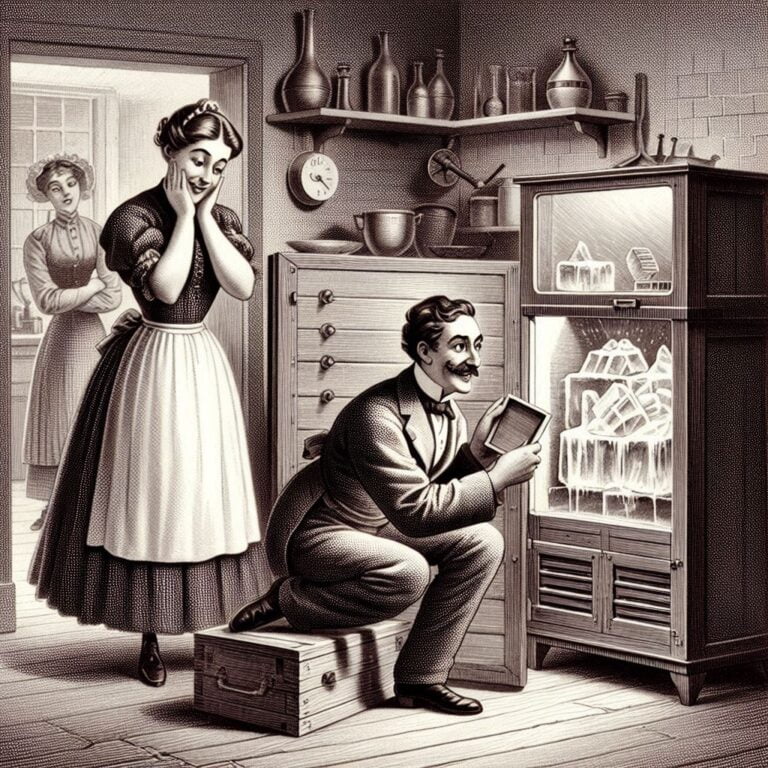The Invention of Photography
At some point, we all have this question who and when photography was invented? Photography is a method of recording of images through light or radiation. The word photography came from two Greek words Phos (Light), Graphis (Drawing/writing) which means writing with light. Drawing with light is different than drawing with a pen, it requires a light-sensitive material, optics and a dark enclosed room. The history of photography begins with two important principles- Camera Obscura image projection and observation of the effect of light exposure on certain substances.
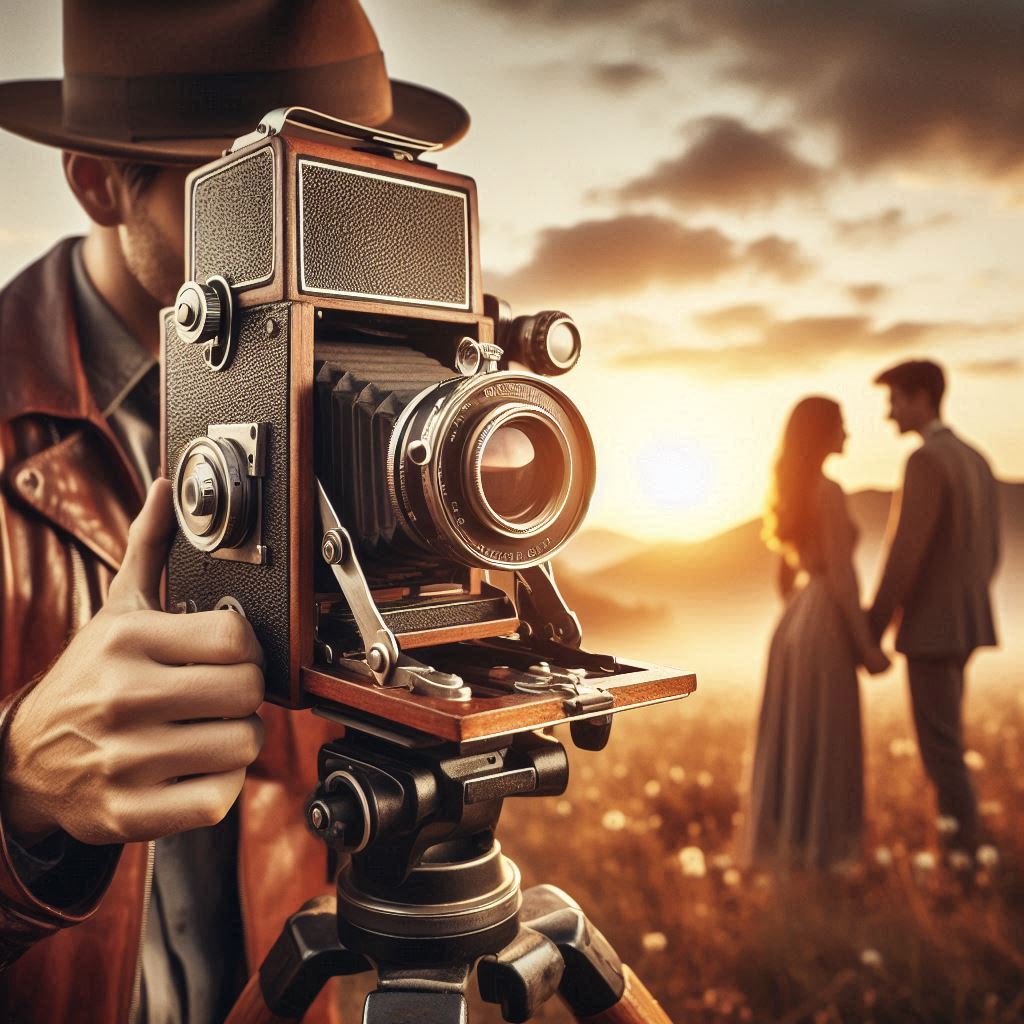
At the beginning of the 19th century, scientists and artists started exploring new ways to capture images and create permanent records of things. In this article, we will explore a detailed overview of the invention of photography, where photography first started, what led to the invention of photography and the key milestones that led to its development.
Pre-photography Era
While the first permanent photograph wouldn’t appear until the 19th century, the seeds of this revolutionary technology were sown thousands of years earlier.
1000 Years ago-
Long before we captured fleeting moments on film, a brilliant Arab scholar named Ibn al-Haytham, known in the West as Alhazen, delved into the mysteries of light and optics around 1021. His magnum opus, the 7-volume “Book of Optics”, wasn’t just a book; it was a revolutionary exploration that profoundly influenced the understanding of light for centuries to come.
Beyond Descriptions: A Life of Experimentation and Innovation
Unlike many scholars of his time who relied solely on theory, Alhazen was a true scientist at heart. He conducted meticulous experiments, meticulously documenting his observations and using logical reasoning to draw groundbreaking conclusions. This hands-on approach led him to uncover fundamental truths about light, including:
- Light travels in rays and straight lines: This seemingly simple principle overturned prevailing beliefs about light emanating from the eye, paving the way for future advancements in lenses and telescopes.
- Image magnification with lenses: Alhazen’s experiments with lenses laid the foundation for the invention of eyeglasses, forever changing the way we see the world.
- Pinhole size and image sharpness: He discovered that adjusting the size of the pinhole in a camera obscura produced sharper projected images, demonstrating his keen understanding of light intensity and focus.
The Camera Obscura: A Vision of the Future
While Alhazen may not have personally built the first camera obscura, his detailed descriptions in the “Book of Optics” were instrumental in its development. This darkened chamber with a small opening projected an inverted image of the outside world onto a screen, offering a glimpse into the potential of capturing and manipulating light.
Early Life
- Alhazen’s early life remains shrouded in some mystery, but records suggest he faced persecution for his progressive views on science and religion.
- Despite the challenges, he remained undeterred, dedicating his life to research and writing. His dedication earned him the title of “The Second Ptolemy” for his groundbreaking contributions to optics.
- The “Book of Optics” wasn’t just a technical treatise; it explored philosophical and psychological aspects of vision, demonstrating Alhazen’s holistic approach to understanding the world.
13th Centuri- The invention of Eyeglasses and Roger Bacon
Roger Bacon, the 13th-century English scholar, wasn’t just a passive conveyor of knowledge. While his book “Opus Majus” (1267) did indeed disseminate Alhazen’s groundbreaking discoveries about optics, Bacon went beyond mere translation. He actively contributed to the evolution of both eyeglasses and the camera obscura:
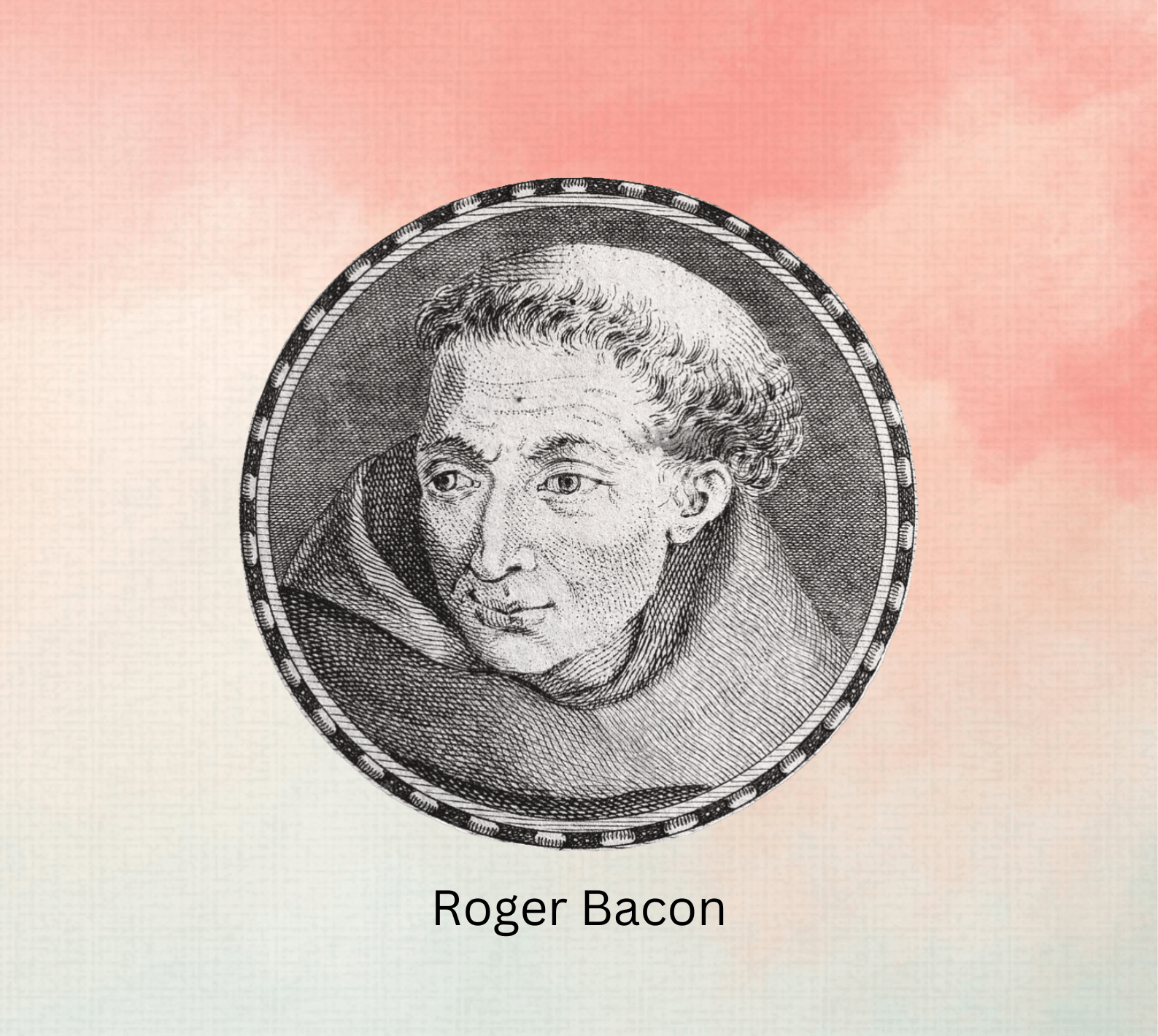
- Beyond Magnification: While magnifying glasses had existed before, Bacon’s detailed descriptions and experiments fueled their widespread adoption, leading to the creation of the first practical eyeglasses. These early spectacles weren’t just for correcting vision but also for scientific observation and reading, impacting various fields.
- Refining the Camera Obscura: Bacon wasn’t just content with understanding the camera obscura’s principle. He actively sought to improve its functionality, potentially contributing to the development of diaphragms to control light and refine image quality.
While history often focuses on the inventor, it’s crucial to acknowledge the role of investors who enabled these innovations to flourish. In Bacon’s case, his patrons included:
- Guy de Beauchamp, Earl of Warwick: A powerful nobleman who supported Bacon’s research and provided financial backing for his experiments.
- Pope Clement IV: Recognizing the potential of Bacon’s work, the Pope offered him access to resources and encouraged his scientific pursuits.
These patrons, along with others, played a crucial role in nurturing Bacon’s genius and ensuring his ideas found fertile ground.
Beyond Europe: A Global Perspective
Remember, the story of optics wasn’t solely European. The camera obscura principle, for instance, was noted by:
- Mozi (4th century BCE, China): His writings described the phenomenon of a pinhole camera, showcasing the concept’s early understanding in different cultures.
- Ibn al-Haytham (10th century, Arabia): While not inventing the camera obscura, his “Book of Optics” delved into light and image formation, laying the groundwork for further developments.
16th Centuri- The Camera Obscura became portable
In 1604 Kepler designed the first portable camera Obscura which has a rotating mechanism to move the lens and mirror to project an image.
Camera Obscura-
While the natural phenomenon of the camera obscura existed since time immemorial, its documented history begins with the Chinese philosopher Mozi around 400 B.C.E. He described the inverted image formation through a small hole, marking the earliest known written record of this natural phenomenon.
From Aristotle to Da Vinci: A Journey of Observation and Refinement:
- 4th Century B.C.E.: Greek philosopher Aristotle observed the principle of the camera obscura during a solar eclipse, noting the inverted image projected on the ground through the leaves of trees.
- 10th Century A.D.: Arab scientist Ibn al-Haytham (Alhazen) conducted extensive research on optics, including the camera obscura. He described its workings in detail and even provided instructions for its construction, solidifying its scientific understanding.
- 15th Century A.D.: Polymath Leonardo da Vinci further explored the camera obscura, documenting its principles and artistic potential in his “Codex Atlanticus”. He even experimented with lenses and portable versions, paving the way for future developments.
 |
| Camera Obscura |
Beyond Observation: Artistic Inspiration and Astronomical Insights:
The camera obscura wasn’t just a scientific curiosity. It became a valuable tool for:
- Artists: Throughout the 16th and 17th centuries, artists like Johannes Vermeer and Canaletto used camera obscura to achieve precise perspective and realistic details in their paintings.
- Astronomers: The camera obscura provided a safe way to observe solar eclipses and study celestial bodies, contributing to our understanding of the universe.
From Tent to Box: The Evolution of Portability:
Early camera obscuras were often large, tent-like structures. However, inventors like Giovanni Battista della Porta in the 16th century and Johannes Kepler in the 17th century created portable box versions, making them more accessible and versatile. These advancements laid the groundwork for the development of the camera as we know it today.
While prominent figures like da Vinci are well-known for their contributions, several other lesser-known individuals played crucial roles:
- Giordano Bruno: This Italian philosopher and astronomer used the camera obscura for astronomical observations and theorized about its potential for capturing images permanently.
- Willebrord Snellius: This Dutch mathematician and astronomer refined the understanding of lenses and contributed to improved image quality in camera obscuras.
- Johann Zahn: This German mathematician and astronomer invented a portable camera obscura with a mirror that projected the image right-side up, making it more user-friendly for artists.
17th Centuri- Light-sensitive material:
Humans have long observed the transformative power of light. From the tanning of skin under the sun to the fading of fabrics, everyday experiences hinted at light’s ability to alter materials. Yet, harnessing this power for image capture remained a distant dream.
Unveiling the Silver Lining: Angelo Sala’s Experiment (1614)
In 1614, Italian physician and chemist Angelo Sala made a crucial discovery. He observed that silver nitrate powder darkened upon prolonged exposure to sunlight. While he couldn’t capture permanent images, Sala had stumbled upon a key property: light’s ability to chemically alter a specific material.
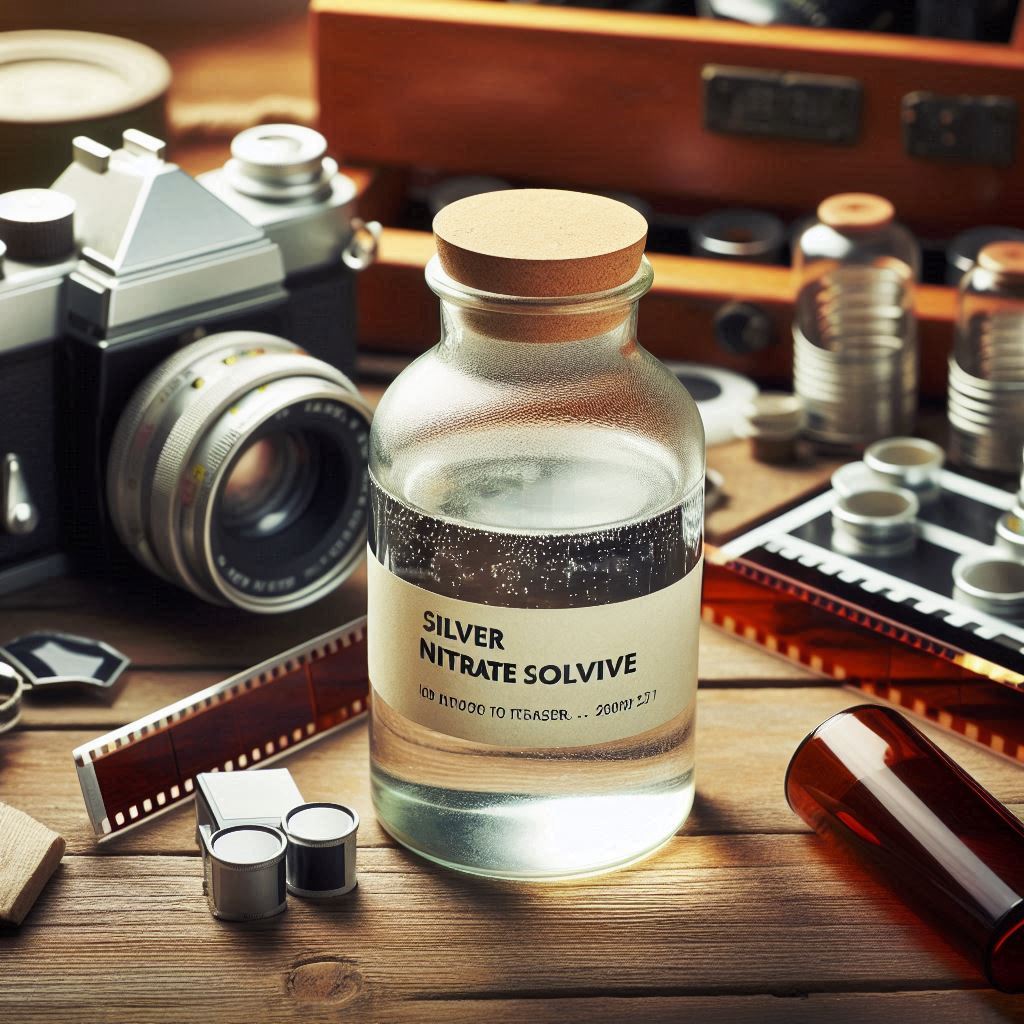
Beyond Silver Nitrate: A Kaleidoscope of Light-Sensitive Chemicals
Sala’s discovery sparked further exploration. Scientists like Johann Heinrich Schulze (1727) and Carl Wilhelm Scheele (1777) experimented with various light-sensitive chemicals, including silver chloride and silver bromide. These investigations revealed a broader range of materials susceptible to light’s transformative power.
Paper’s Role: Capturing the Ephemeral:
Observing that paper exposed to silver nitrate alongside objects also darkened, researchers like Johann Heinrich Schulze realized paper could act as a recording medium. This marked a significant step towards capturing fleeting images.
From Curiosity to Collaboration: Building upon Each Other’s Work
The journey wasn’t linear. Many scientists contributed, building upon each other’s discoveries. For example, Thomas Wedgwood (1802) used sunlight to create silhouettes on paper coated with silver chloride, while Humphry Davy (1802) observed that light intensity influenced the degree of darkening.
The Puzzle Nears Completion: Understanding Light’s Action on Chemicals
Despite these advancements, researchers faced a crucial hurdle: the image darkened upon further exposure to light, preventing permanence. It wasn’t until Sir John Herschel (1839) discovered that sodium thiosulfate could fix the image, making it stable to further light exposure, that a crucial piece of the puzzle fell into place.
The Legacy: Setting the Stage for Photography
By the early 19th century, the understanding of light-sensitive materials was reaching a critical point. With permanent image fixation achieved, inventors like Louis Daguerre and Joseph Nicéphore Niépce were poised to usher in the era of photography.
1826- The First Photograph
While often remembered for the “first photograph,” Joseph Nicéphore Niépce was much more than just a single invention. A true pioneer, he spent years experimenting with light sensitivity and image capture. Here are some fascinating details about him:
- Driven by a Passion: Niépce, born in 1765 in France, wasn’t formally trained in science but possessed an insatiable curiosity and a passion for capturing reality.
- Early Experiments: He initially explored using silver salts, similar to the later daguerreotype process, but found them impermanent.
- Years of Persistence: From 1816 onwards, Niépce tirelessly experimented with various light-sensitive materials, finally settling on bitumen, a natural asphalt.
- Partnership and Collaboration: He initially partnered with Louis Daguerre, another photography pioneer, but their approaches differed, leading them to work independently later.
The Birth of the “Heliograph” and its Challenges:
Niépce’s creation wasn’t simply a photograph; it was a unique process he named “heliography.” Here are some key aspects:
- Bitumen’s Sensitivity: The bitumen coating on a pewter plate was light-sensitive, darkening in areas exposed to light.
- The Camera Obscura: He used a camera obscura to project the image onto the plate, essentially creating a long exposure.
- Eight Hours of Sunlight: The image required an exposure time of eight hours, showcasing Niépce’s dedication and patience.
- Developing the Image: After exposure, the plate was washed with a solvent, revealing the captured scene in varying shades of gray.
The “View from the Window”: A Blurry Yet Historic Image:
The resulting photograph, titled “View from the Window at Le Gras,” was far from perfect. It depicted a blurry scene from Niépce’s window, showcasing rooftops and distant hills. However, its significance transcended its imperfections:
- The First Permanent Image: Unlike earlier attempts, this image was permanent and didn’t fade over time.
- A Milestone Achieved: It marked the first time a camera captured an image without human intervention, paving the way for future advancements.
- Inspiration for Others: Niépce’s work inspired other inventors like Daguerre, who further refined the technology.
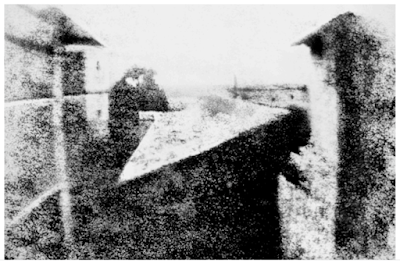 |
| First Photograph in History |
Beyond the Blurry Image: A Legacy of Innovation:
While the “View from the Window” may not be aesthetically pleasing, its historical importance cannot be overstated. It was the first step in a journey that revolutionized how we capture and share the world around us. Here are some additional points to consider:
- Building upon Existing Knowledge: Niépce wasn’t the first to explore the camera obscura or light-sensitive materials. He built upon centuries of scientific and artistic knowledge.
- A Collaborative Effort: Photography’s development wasn’t solely Niépce’s achievement. It involved contributions from numerous individuals, each adding their unique piece to the puzzle.
- The Ongoing Journey: The “first photograph” wasn’t the end; it was the beginning. Photography has continued to evolve, transforming from its blurry beginnings to the digital marvels of today.
1839-Daguerreotype:
The Inventor- Louis Daguerre:
Born in France in 1787, Louis Daguerre was an artist and panorama painter deeply fascinated by the possibilities of light. In 1826, he partnered with Nicéphore Niépce, a pioneering scientist, to explore the uncharted territory of capturing light permanently. Despite Niépce’s tragic death in 1833, Daguerre persevered, driven by an unwavering vision.
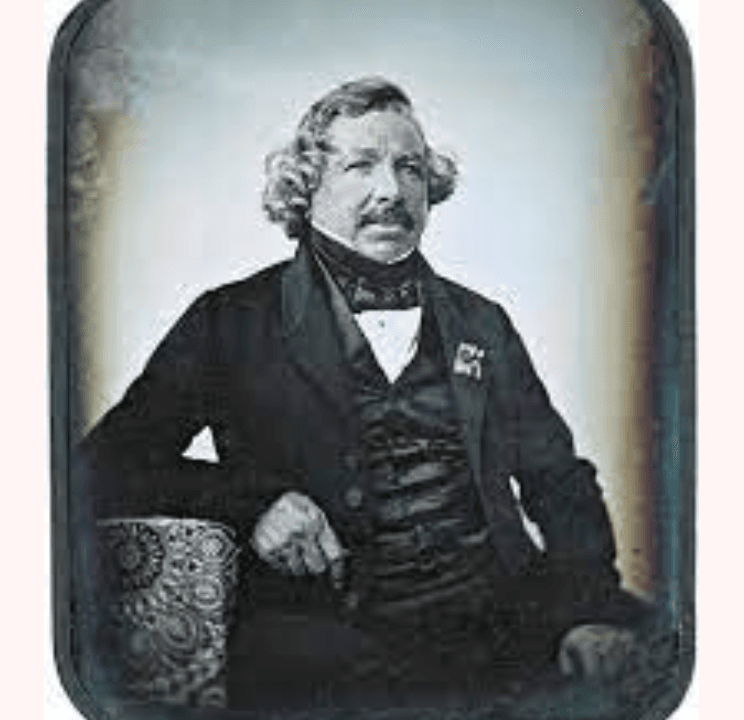
1839: The Birth of the Daguerreotype – A Monumental Leap:
After years of experimentation, Daguerre finally unveiled his revolutionary process in 1839. Unlike Niépce’s time-consuming method, the daguerreotype offered:
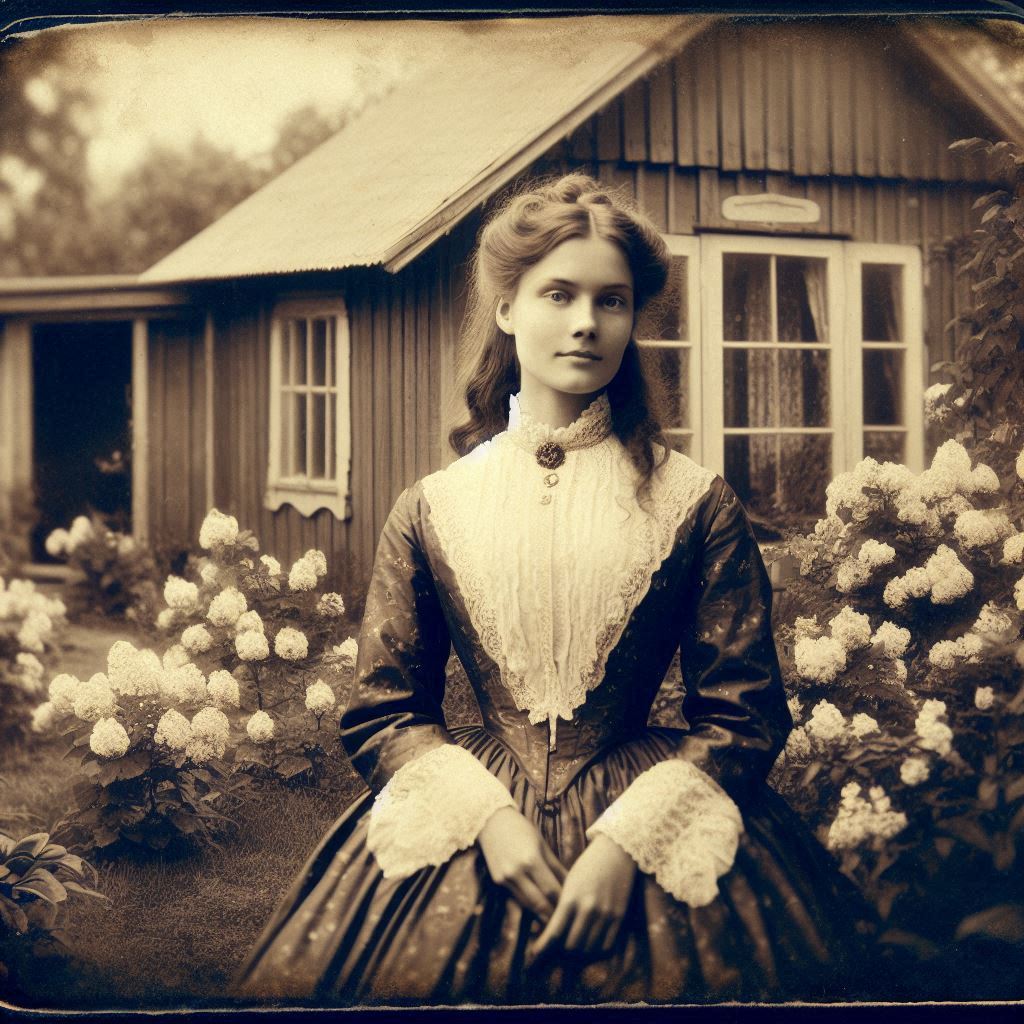
- Faster Exposure Times: Gone were the hours-long exposures of Niépce’s process. Daguerreotype exposures ranged from a few seconds in bright sunlight to several minutes in dimmer conditions, making portraiture and capturing fleeting moments possible.
- Direct Positives: Unlike Niépce’s negative requiring further manipulation, the daguerreotype produced a direct, one-of-a-kind positive image, removing the need for additional steps and enhancing its appeal.
- Exquisite Detail: The polished silver plate captured intricate details with remarkable sharpness, surpassing the quality of any previous photographic process.
The Process Unveiled: A Symphony of Light and Chemistry:
The daguerreotype process was a complex dance between light and chemicals:
- Preparing the Plate: A highly polished copper plate was coated with a light-sensitive layer of silver iodide.
- Capturing Light: The plate was placed in a camera and exposed to light, creating a latent image invisible to the naked eye.
- Mercury Development: The plate was then fumed with heated mercury vapor, revealing the latent image and creating the visible picture.
- Fixing the Image: To prevent further light sensitivity, the plate was treated with a salt solution, “fixing” the image permanently.
- Sealing and Protection: Finally, the delicate image was sealed with a protective layer, often housed in a decorative case or locket.
Beyond Portraits: A Window to the World:
While renowned for its exquisite portraits, the daguerreotype captured far more:
- Landscapes: Breathtaking landscapes were documented, offering a glimpse into diverse environments and inspiring travel photography.
- Scientific and Historical Records: The daguerreotype served as a valuable tool for documenting scientific experiments, archaeological discoveries, and historical events, preserving them for posterity.
- Early Journalism: Photographers like Roger Fenton used daguerreotypes to document the Crimean War, offering a glimpse into the realities of conflict and shaping war photography.
Despite being superseded by later photographic techniques, the daguerreotype’s impact was profound:
- Democratization of Photography: It made photography accessible to a wider audience, fueling a fascination with capturing the world around us.
- Artistic Inspiration: The daguerreotype’s realism and detail inspired artists like the Impressionists, who sought to capture fleeting moments and light effects in their paintings.
- Historical Record: Daguerreotypes serve as invaluable historical documents, offering a window into the past and preserving moments for future generations.
1841-Calotype:
While William Henry Fox Talbot is rightly credited as the inventor of the calotype in 1841, it’s important to acknowledge the collaborative efforts that led to its creation. Talbot, a scientist and polymath, built upon earlier discoveries by:
- Thomas Wedgwood: This English potter experimented with light-sensitive chemicals in the late 18th century, laying the groundwork for photographic processes.
- Sir John Herschel: A renowned astronomer, Herschel discovered the fixing properties of sodium thiosulfate, a crucial step in making photographic images permanent.
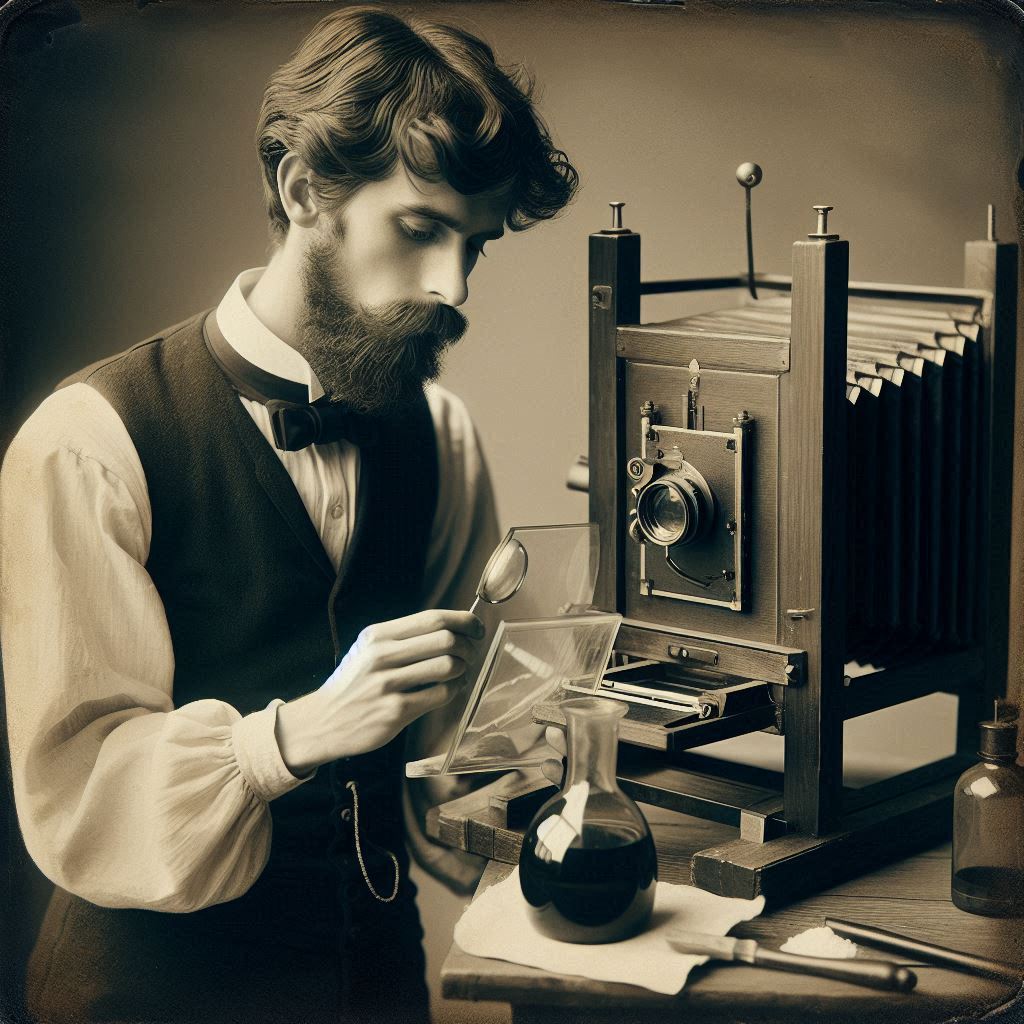
From Frustration to Innovation: Talbot’s Journey:
Talbot’s initial attempts at photography involved creating “photogenic drawings,” which were camera-less impressions of objects. Frustrated by their fleeting nature, he continued his research, eventually stumbling upon the calotype process.
More than Just a Paper Negative:
The calotype’s significance goes beyond its multiple prints. Here’s why it was groundbreaking:
- Gentler on the eyes: Unlike the daguerreotype’s harsh metallic surface, the calotype’s paper negative offered a softer, more natural-looking image.
- Scientific applications: The ability to reproduce images made the calotype invaluable for scientists documenting discoveries and sharing information.
- Artistic expression: The calotype’s unique aesthetic appealed to artists like Henry Peach Robinson, who used it for photorealistic tableaux and early explorations of storytelling through photography.
Challenges:
While the calotype offered advantages, it wasn’t without limitations:
- Long exposure times: Early calotypes required lengthy exposures, limiting their practicality for capturing moving subjects.
- Fragile negatives: The paper negatives were prone to damage and deterioration, requiring careful handling.
- Complex process: The calotype process involved multiple steps and chemicals, making it more challenging for amateurs compared to later advancements.
Digital Photography
The rise of digital photography wasn’t just a singular invention, but a culmination of decades of innovation, fueled by visionary individuals and groundbreaking technologies. Let’s delve into this fascinating journey, enriching it with lesser-known details and historical references:
Before the Pixels: Laying the Foundation (1870s – 1950s)
While Russell Kirsch’s work marked a significant milestone, the seeds of digital photography were sown much earlier:
- 1870s: Joseph Henry: Pioneered the idea of capturing images electronically using a light-sensitive selenium plate.
- 1920s: Vladimir Zworykin: Invented the iconoscope, an early television camera tube that utilized a photosensitive surface and scanning technology, paving the way for image capture and transmission.
- 1931: Russell Ranger: Developed a prototype television system that recorded images on film but laid the groundwork for digital image capture.
- 1950s: Bell Labs: Developed the first working transistors, miniaturized electronic components crucial for creating portable digital cameras.
1957: The Pixelated Birth of Digital Photography:
Russell A. Kirsch and his team at the National Bureau of Standards undoubtedly made history in 1957. Their binary digital system and wire drum photo scanner digitized the first image: a photo of Kirsch’s son, Walden, with 176 x 176 pixels and a single bit per pixel. While rudimentary, it marked a giant leap forward.
1969: The Charge-Coupled Revolution:
The invention of the Charge-Coupled Device (CCD) by Willard Boyle and George E. Smith at Bell Labs in 1969 proved pivotal. This optoelectronic component captured light electronically and could be miniaturized, paving the way for practical digital cameras.
1986: Kodak and the Rise of the Megapixel:
While Kodak might not be the first name synonymous with digital cameras, their 1986 development of the first-megapixel sensor was a game-changer. This significant increase in resolution marked a significant leap towards high-quality digital photography.
![]()
Beyond the Inventors: Unsung Heroes of Digital Photography:
While Kirsch, Boyle, Smith, and Kodak played crucial roles, several others contributed:
- Steve Sasson: An engineer at Kodak, he built the first portable digital camera in 1975, though it wasn’t commercially available.
- Fujifilm: Invested heavily in CCD technology and released early commercial digital cameras in the 1980s.
- Eric Fossum: Invented the CMOS (Complementary Metal-Oxide-Semiconductor) sensor in 1993, a smaller, more energy-efficient alternative to CCDs, now dominant in most cameras.
The Impact: A Revolution in Image Capture:
Digital photography’s impact is undeniable:
- Accessibility: Eliminated the need for film and processing, making photography affordable and accessible to everyone.
- Convenience: Instant image viewing, editing, and sharing transformed how we capture and share memories.
- Professionalism: High-resolution cameras empowered professional photographers with new possibilities.
Looking Ahead: The Future of Pixels
The story of digital photography is far from over. Advancements in sensor technology, artificial intelligence, and computational photography continue to push the boundaries of what’s possible, ensuring a future filled with even more captivating and innovative ways to capture the world around us.
 |
| Digital Cameras |
Russel A. Kirsch led a team at the National Institute of Standards in 1957 to develop the binary Digital system into the existing technology. With the help of a wire drum photo scanner, we could transfer the data like characters, photos diagrams and other graphics into the computer memory. The first photo scanned by this technology was Kirsch’s young son Waldon with a resolution of 176*176 pixels & one bit per pixel.
In 1969 Willard Boyle and George E. Smith invented CCD (Charge-Coupled Device) which is the optoelectronic component in first-generation cameras. It continued improving and in 1986 Kotak developed the first megapixel Sensor.
Digital photography has electronic sensors to capture images, rather than film. The images are stored on digital memory cards and can be viewed and manipulated on a computer or other electronic device. Digital photography has revolutionized the field of photography, making it more accessible and convenient for amateur and professional photographers alike.
Conclusion
The invention of photography isn’t simply a footnote in history; it’s a transformative thread woven into the very fabric of our lives. Its impact expands far beyond capturing light, casting a profound shadow on various aspects of human experience:
History’s Mirror: From documenting wars and social movements to preserving personal memories, photography stands as a visual chronicle of our past. Each click of the shutter freezes a moment in time, offering invaluable insights into bygone eras, cultures, and individuals.
Memory’s Guardian: Beyond historical records, photography empowers us to immortalize personal moments. Birthdays, graduations, weddings, and everyday interactions – these precious snippets of life are enshrined, allowing us to revisit them and relive emotions whenever we choose.
Communication Revolution: Photography transcends words, bridging cultural and linguistic barriers. A single image can convey powerful messages, evoke emotions, and spark dialogue in ways text alone often struggles to achieve. This visual storytelling ability has revolutionized communication across fields like journalism, advertising, and social media.
Industry Incubator: From photojournalism and fashion photography to advertising and fine art, photography has birthed and nurtured entire industries, providing livelihoods and artistic expression for countless individuals.
Scientific Spotlight: The keen eye of the camera doesn’t just capture beauty; it unveils the unseen. In science and medicine, photography has become an indispensable tool, aiding in research, diagnosis, and documentation of minute details with unparalleled precision.
A New Worldview: Photography has gifted us a new perspective on the world around us. It allows us to see details invisible to the naked eye, appreciate fleeting moments, and capture the essence of fleeting emotions. This expanded perspective enriches our understanding of ourselves and the world we inhabit.
Sharing Stories: Photography fosters connection by enabling us to share our experiences with others. Travel photos transport us to new landscapes, family portraits evoke shared memories, and artistic expressions offer glimpses into unique mindscapes. By bridging these visual bridges, photography fosters empathy and understanding across borders and cultures.
The invention of photography wasn’t just a technological marvel; it was a cultural and societal game-changer. Its legacy continues to evolve, offering exciting possibilities for the future. As technology advances and new forms of visual storytelling emerge, one thing remains certain: photography’s impact on our lives will continue to be profound and enduring.
Check out our other interesting blogs-




